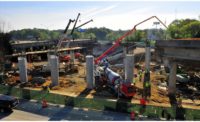"We've seen a big increase in ridership as we've added additional service, improved the stations and made the trips more reliable and predictable," Conti says. "We're really interested in using rail to reduce and mitigate some of the urban congestion we have, and to just provide people with another option."
Quick Fix
Hurricane Irene put NCDOT's Division One to the test when it lashed the Outer Banks in August 2011 and destroyed a section of State Route 12, the only road connecting the well-known barrier islands to the mainland. Irene's slow-moving track created unprecedented surges that severed Route 12 with a 200-ft-wide, 8-ft-deep inlet in the Pea Island National Wildlife Refuge, and a smaller breach near the village of Rodanthe.
While the gap at Rodanthe could be filled in with sand and repaved, NCDOT decided to install a 662-ft, five-span Mabey Universal Bridge at the Pea Island breach. Erected by Carolina Bridge Co., Orangeburg, S.C., the structure's ease of construction and durability enabled the agency to reopen Route 12 in six weeks.
AGC's Jenkins terms NCDOT's storm response "an outstanding job." He says the agency "did a good job of having a crisis team set up to deal with it, and they staged the work to do it very quickly."
Planning Improvement
The emphasis on planning lies at the heart of the department's recent successes. From the high-speed rail funding awards to financial stability and the solid response to disaster in the Outer Banks, that focus on solid planning appears to be paying dividends.
As plans for reauthorizing the federal transportation program lurch ahead in Washington, state transportation departments, including North Carolina's, will need this discipline to maintain progress. "Resources are always an issue," says Conti. "You have to have systems to prioritize needs and deal with the most important issues first."
Conti adds that "we're moving well in a positive direction on all fronts, but it's a continuous process of improvement, not a journey to perfection."









Post a comment to this article
Report Abusive Comment